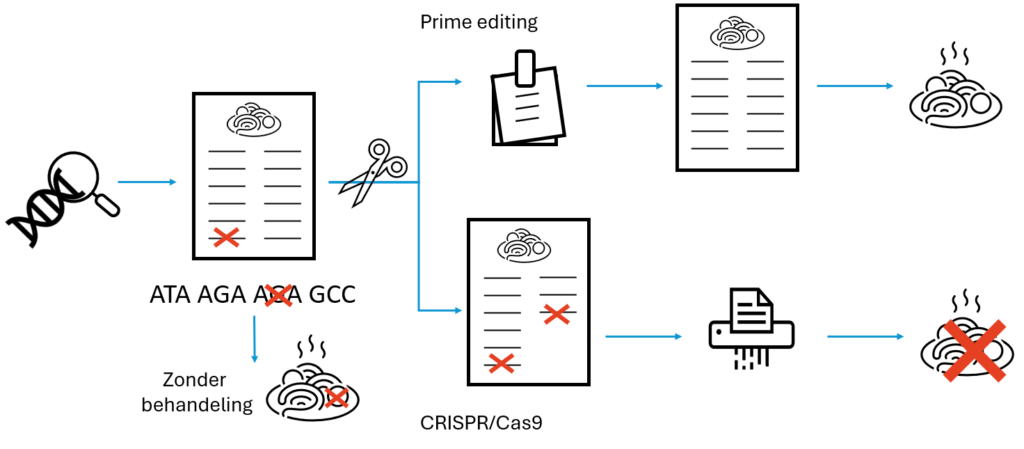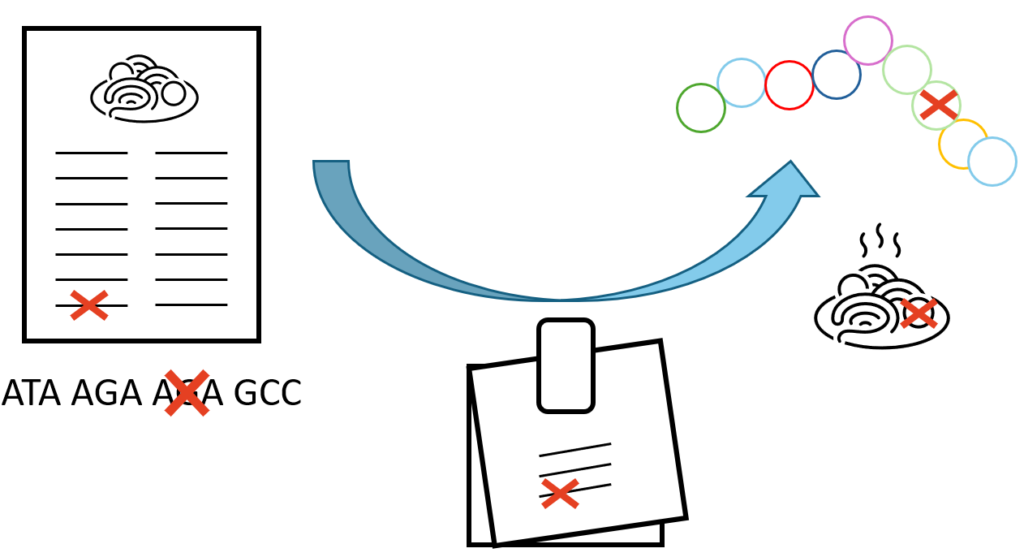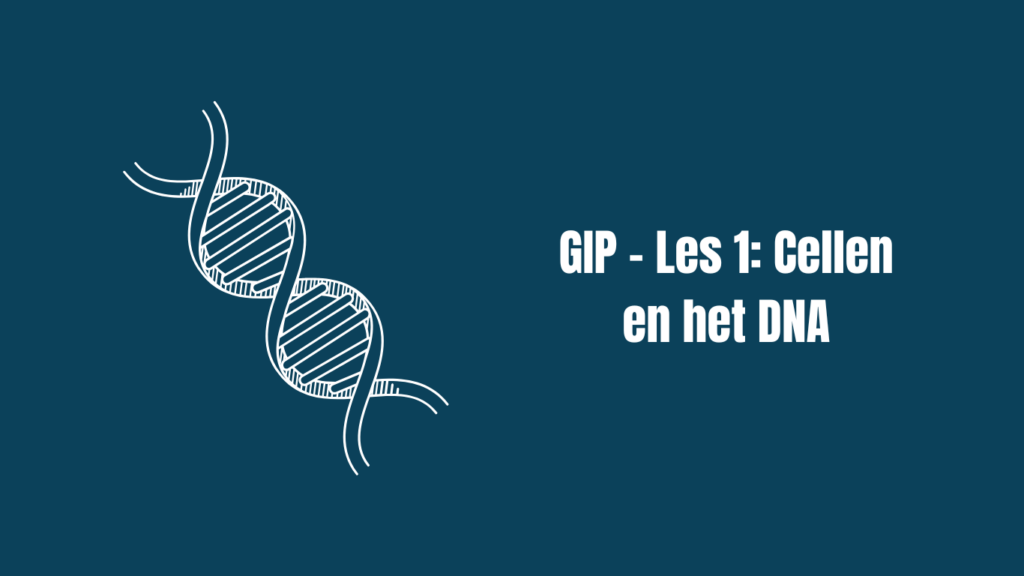With GIP (gene therapy information packet), we take you into the world of gene therapy. In recent years there has been a lot of research into gene therapy. This has provided insight into whether and how gene therapy can help with a treatment for PLN-R14del. We will take you into the world of gene therapy. In this first lesson, we will tell you how genes work, what is changed in PLN-R14del and how this causes problems.
Overview gene therapy information packet:
- The gene therapy information packet!
- BIP – Lesson 1: Cells and DNA.
- BIP – Lesson 2: Possible gene therapies.
- BIP – Lesson 3: Risks and concerns.
- GIP – Lesson 4: Existing gene therapies.
Cells and the DNA
The human body is made up of cells. For example, the brain is made up of nerve cells, the skin is made up of skin cells and the heart is made up of heart muscle cells. Cells are made up of different parts. Inside each cell is a nucleus where the cookbook for building the cell is kept and used to regulate the cell. This instruction book is the DNA, the genome. In addition to the nucleus, the cell consists of other units including energy factories, a skeleton, small vesicles that allow communication with the environment and a large structure that makes and modifies proteins so they can perform their function.
So the nucleus controls the cell and contains a kind of cookbook we call the DNA. The cookbook consists of recipes that can be translated into a dish (see Figure 1). In this equation, the recipe is a gene and the dish is a protein. Each protein has a specific function in the cell. For example, a protein may be involved in communication, in transporting food into the cell, or in the structure of the cell. To turn the gene (recipe) into a protein (dish), the gene must first be converted into RNA.
So RNA is a kind of shopping list with what should be written in the recipe. So the order is DNA (the storage in the nucleus), RNA as an intermediate, and then protein (which can perform a function). DNA is made up of four building blocks that are designated by the letters A, C, T and G. A always binds to T and C always binds to G. This creates a kind of staircase that connects the two DNA strands together like a kind of long DNA staircase. The DNA is translated into RNA consisting of similar letters. Each time, three of these RNA letters form an ingredient of a recipe, that is, a building block of the protein. These building blocks are called amino acids. So a central rule within biology is: the DNA of genes is translated into RNA from which proteins can be made.

Figure 1 DNA is the cookbook (instruction book) of the cell; it contains recipes (the genes). From these recipes, shopping lists (RNA) are made that can be converted into a dish (the protein).
Now it is true that each cell contains DNA from your father and from your mother. So actually, each cell has two cookbooks, one from your father and one from your mother. Both books contain the same recipes (with the exception of sex hormones). All genes require both cookbooks: both copies of the recipe are needed for the cell to function properly. Wonderful huh, how you need a father and mother to get a cell complete so that it works properly!
Flaws in DNA
Growth and maintenance of the body requires the creation of new cells. To make a new cell, a cell divides into two new cells. In the process, the DNA is overwritten so that both cells take a copy with them. Although this is done with incredible precision, occasional mistakes sneak in. In addition, there are molecules in the cell and outside influences, such as toxins or UV radiation, that cause changes to occur in the DNA. The cell has an elaborate machinery to fix these errors, but unfortunately not every error is fixed properly. And so about 600-800 years ago, an error (mutation) occurred in an inhabitant of southeastern Friesland in the phospholamban gene.
The piece of DNA there reads: ATA AGA AGA GCC and that is changed to ATA AGA …GCC (Figure 2). As you can see, the building block AGA is in the original recipe twice in a row. It is possible that this is what caused the change (just as you are more likely to skip a “you” in the sentence “Have you finished your apple yet?”). The building block AGA encodes for the amino acid arginine, so PLN R14del (R stands for arginine, so aRginineat spot 14 isdeleted) is missing an arginine.

Figure 2 In R14del, an AGA is missing an ingredient on the shopping list, making the dish incomplete.
What goes wrong with PLN R14del?
Now you might ask: if you have two copies of the PLN gene and one is broken, the other one still works fine right? That’s quite true, but still that’s not enough. In fact, for some of your genes, you need two healthy copies. This may be because the altered protein binds to the good protein, preventing both from doing their job properly, or because it simply takes more protein than one gene produces. It may also be that the altered protein will perform another function that disrupts the cell. Although this process is not entirely clear, we do know that the altered PLN protein causes several problems.
Let’s see what problems the altered PLN gene causes within the cell, at the tissue level and in the function of the heart. Within the cell, a number of processes become disrupted. First, PLN is involved in regulating the amount of calcium in the cell. This is very important in a heart cell because calcium is needed for the contraction of the heart muscle. Second, there is a recycling machine in the cell for proteins to be broken down (a kind of waste disposal). In PLN, this recycling machine is disrupted, causing the cell to become stressed and may even die. Third, a heart cell is constantly working to supply the body with blood. Because of this, a heart cell uses a lot of energy. The energy supply is often disrupted in heart diseases and so it is in PLN.
Finally, the heart is activated by electrical signals from the sinus node. These signals are passed through each cell so that each cell contracts at the right time. In PLN, the connections between the cells, say the electrical wires, are disrupted so the signal cannot be transmitted as well. If we zoom out a bit, we can see that together these processes cause heart tissue to be replaced by fat and connective tissue and immune cells to enter the heart. If this process stealthily continues and gets worse, eventually heart failure and/or arrhythmias occur. Therefore, these are the two manifestations of PLN R14del.
Is gene therapy the solution to PLN?
Currently, the only therapies available for PLN, besides a heart transplant, are those that treat the symptoms. There is no real cure. It is possible to make “normal” drugs that work better, but with these it is at best possible to slow down the disease. And even if an ordinary pill could inhibit PLN well, developing an ordinary pill is more cumbersome than gene therapy. In theory, it is also possible to repair the real damage to the heart (that heart muscle tissue is lost and replaced by fat and connective tissue). In practice, however, this is incredibly complicated and not yet a therapy that can be administered to patients.
To cure a PLN patient we will have to go a level deeper and solve the problem at the DNA or RNA level so that the disruptions in the cell are repaired or prevented. This allows us to work in a very targeted way and can also speed up the development of a treatment (provided a number of conditions are met). However, there are also specific disadvantages to gene therapy. More on that in the third lesson. In the second lesson, we will first discuss the various promising possibilities of gene therapy.
